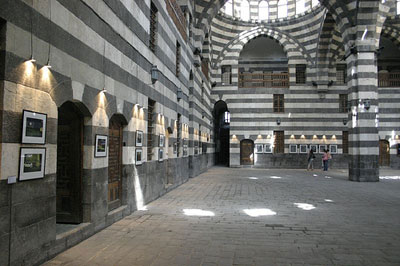Khan As’ad Pasha is the largest khan in the Old City of Damascus, covering an area of 2,500 square meters (27,000 sq.ft.). Situated along Al-Buzuriyah Souq, it was built and named after As’ad Pasha al-Azm, the governor of Damascus, in 1751-52. Khan As’ad Pasha has been described as one of the finest khans of Damascus, and the most “ambitious” work of architecture in the city.
The building follows a typical khan layout with two floors giving onto a central courtyard. Khan As’ad Pasha is entered from souq al-Buzuriyyah, through a monumental gateway decorated with stone carvings and roofed by a muqarnas semi-dome. The entrance leads to a square-shaped courtyard with old shops on the ground floor. The second floor, accessible by a staircase located to the right of the main entrance, was used mainly for lodging and has eighty rooms arranged along a gallery facing the courtyard.
The space of the central courtyard is divided into nine equal square modules, where each module is covered with a dome raised on a drum pierced with twenty windows. The domes are supported by pendent that transfer the load onto four piers and to the courtyard walls. An octagonal marble fountain occupies the center of the courtyard below the central dome. Each of the four courtyard walls has three doorways on the ground floor, flanked by two rectangular windows. The symmetry is maintained on the second floor where each gallery façade has three archways flanked by two smaller ones. The khan is built of alternating courses of basalt and limestone.
Three of the courtyard domes were destroyed in an earthquake in 1758. The openings were covered with wooden planks until 1990 when the khan was restored and the domes rebuilt. At the beginning of the 20th century, Khan As’ad Pasha was no longer used for commercial purposes. Until its restoration in 1990, it was used for manufacturing and storage. Today, it is designated as a tourist site and hosts the Natural History Museum of Damascus.
Raghda Sawas

